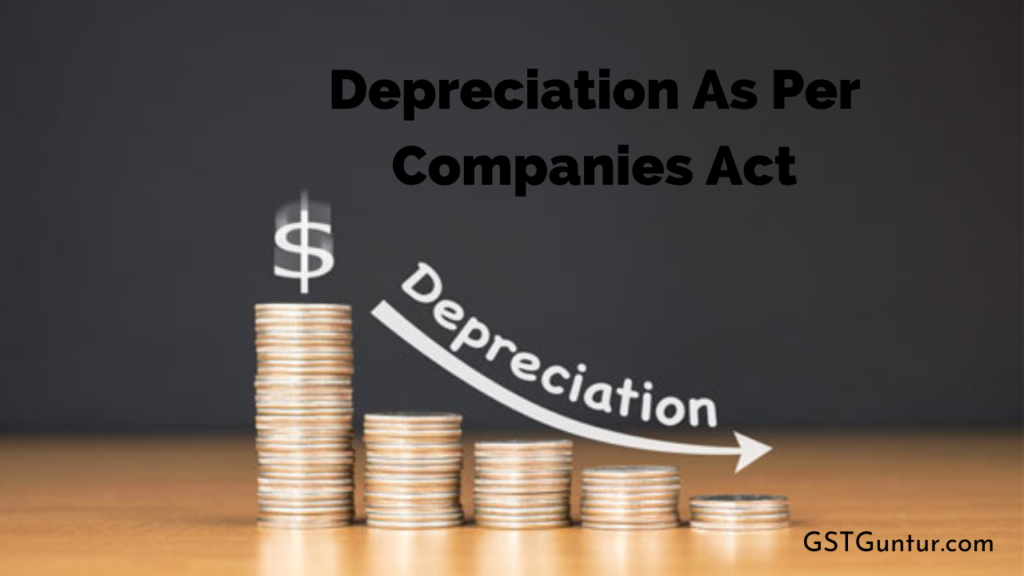Depreciation As Per Companies Act: Depreciation, as per the companies acts 2013, is “ Depreciation is the systematic allocation of the depreciable amount of an asset over its useful life. The depreciable amount of an asset is the cost of an asset or another amount substituted for cost, less its residual value”.
Depreciation is calculated for two reasons:
- Accounting- It covers two sides, firstly, decrease in the value of assets and allocation of the cost of help to the useful life of assets.
- Taxation-It refers to the reduction in net taxable income to reduce the amount of tax payable.
Methods to Calculate Depreciation as Per Companies Act, 2013
Straight Line Method
Straight-line depreciation is a method for calculating the value of depreciation of a fixed asset over a period of time. In this method, a constant rate of depreciation is taken for a particular asset. Depreciation is calculated for a specific asset for a year and then the same amount is deducted every year.
Written Down Value Method
Written down value depreciation is a method in which a constant rate of depreciation is applied to the net book value of assets each year, therefore more depreciation expenses in the early years of the life of the asset and less depreciation in the later years of the life of the asset.
Schedule II Of The Companies Act 2013
Depreciation as per companies acts 2013 requires an asset to be depreciated over its useful life whereas the old Schedule XIV of the companies act 1956 which requires minimum rates of depreciation to be provided by a company. According to Section 123 of the companies act 2013, depreciation will be calculated as per Schedule II and for the assets which have been bought into force from 1 April 2014.
The useful life of an asset is the period for which an asset is expected to be available to be used by an entity. Over here, depreciation holds the word amortization.
The date of purchase is very important to calculate the remaining useful life of the asset as of 1.4.2014. Existing assets are depreciated over the remaining useful life as of 1.4.2014.
Transitional Effect of Schedule II
The important factor to be shown in the books of account is the effect of this transition on 1st April 2014. According to Note 7 to part C of Schedule II from the date given the carrying amount of the asset as of that date will be:
Depreciated over the remaining useful life of the asset. The residual value will be recognized in the opening balance of the retained earnings where the remaining useful life of an asset is nil.
There are two scenarios for the assets as of 1st April 2014,
Asset’s remaining useful life as per Schedule II is nil: In this case, the carrying amount has to be adjusted in the opening balance of the retained earnings in the balance sheet after keeping the residual value.
Asset’s remaining useful life is as per schedule II is not nil: In this case, we continue depreciating the balance as of 1 April 2014 over the remaining useful life after recalculating the amount of depreciation. So, in that case, no effect of restating the carrying amount will be required to be given.
Method of Calculation of Depreciation as per Companies Act 2013
Rate of Depreciation under Written down value method
R = ( 1- n * s/c)* 100
Where R = Rate of Depreciation(in %)
n = Useful life of the asset (in years)
s = Scrap value at the end of the useful life of the asset
c = Cost of the asset
The depreciation rates applicable to some of the assets, if the asset is purchased on or after 1st April 2014 and useful life is considered as given in companies act 2013 and residual value as 5% is given below in the table.
Depreciation Rate as Per Companies Act for Some Assets
| Nature of assets | Useful life | Rate (SLM) | Rate (WDV) |
| Buildings | |||
| Building (other than factory buildings) RCC frame structure | 60 | 1.58% | 4.87% |
| Building( other than factory buildings) other than RCC frame structure | 30 | 3.17% | 9.50% |
| Factory buildings | 30 | 3.17% | 9.50% |
| Fences, walls, tube wells | 5 | 19.00% | 45.07% |
| Other (including temporary structure) | 3 | 31.67% | 63.16% |
| Bridges, culverts, bunkers | 30 | 3.17% | 9.50% |
| Roads | |||
| Carpeted roads | |||
| Carpeted roads-RCC | 10 | 9.50% | 25.89% |
| Carpeted roads- other than RCC | 5 | 19.00% | 45.07% |
| Non-carpeted roads | 3 | 31.67% | 63.16% |
| Furniture and fittings | |||
| General Furniture and fittings | 10 | 9.50% | 25.89% |
| Furniture and fittings used in hotels, restaurants and boarding houses, schools, colleges and other educational institutions, libraries, welfare centres, meeting halls, cinema halls and theatres and circuses and furniture and fittings let out on hire for use on the occasion of marriages and similar functions. | 8 | 11.88% | 31.23% |
| Motor Vehicles | |||
| Motorcycles, scooters and other mopeds | 10 | 9.50% | 25.89% |
| Motor buses, motor lorries, motor cars and motor taxies used in a business of running them on hire | 6 | 15.83% | 39.30% |
| Motor buses, motor lorries, motor cars and motor taxies other than those used in a business of running them on | 8 | 11.88% | 31.23% |
| Motor tractors, harvesting combines and heavy vehicles | 8 | 11.88% | 31.23% |
| Electrically operated vehicles | 8 | 11.88% | 31.23% |
